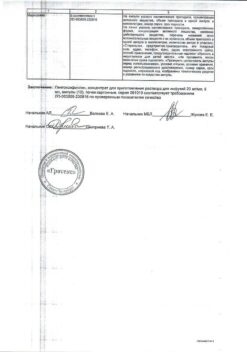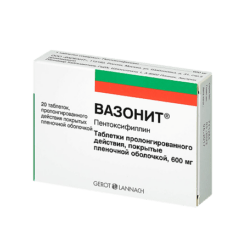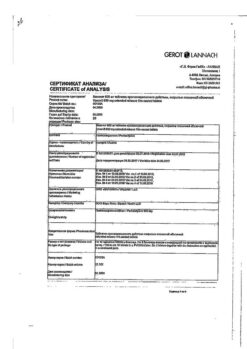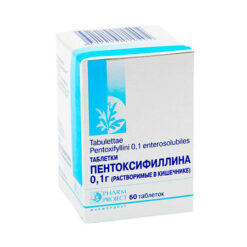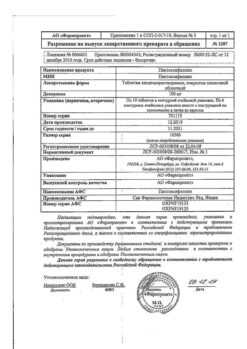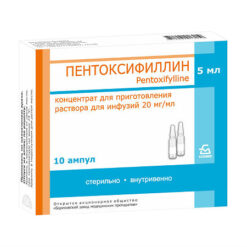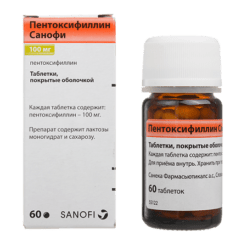No products in the cart.
Pentoxifylline, 100 mg 60 pcs
€1.00
Out of stock
(E-mail when Stock is available)
Description
Pharmacotherapeutic group: Vasodilator.
ATX: C04AD03
Pharmacological properties
Pentoxifylline improves microcirculation and rheological properties of blood, has vasodilator effect, blocks phosphodiesterase and promotes accumulation of cAMP in cells. Pentoxifylline inhibits platelet and erythrocyte aggregation, increases their elasticity, reduces the level of fibrinogen in the plasma and enhances fibrinolysis, which reduces blood viscosity and improves its rheological properties. It has a weak myotropic, vasodilator effect. Pentoxifylline slightly reduces total peripheral resistance and slightly dilates coronary vessels.
In general, Pentoxifylline causes improvement of microcirculation and tissue oxygen supply in the brain and extremities, to a lesser extent in the kidneys.
Pharmacokinetics
Pentoxifylline is almost completely absorbed from the gastrointestinal tract after oral administration. The drug undergoes “first passage” through the liver to form 2 main pharmacologically active metabolites: 1-5-hydroxyhexyl-3,7-dimethylxanthine (metabolite 1) and 1-3-carboxypropyl-3,7-dimethylxanthine (metabolite V). Plasma concentrations of metabolite I and V are, respectively, 5 and 8 times higher than those of pentoxifylline. Time of reaching maximum concentration is 1 hour. The elimination half-life is 0.5 – 1.5 hours.
Pentoxifylline is excreted mainly by the kidneys – 94 % as matabolites (mainly metabolite V), by the intestine – 4 %, in the first 4 hours up to 90 % of the dose is excreted. It is excreted with breast milk. Excretion of metabolites is delayed in severe renal dysfunction. In liver dysfunction there is prolongation of the elimination half-life and increased bioavailability.
Indications
Indications
Active ingredient
Active ingredient
Composition
Composition
Each enteric-coated tablet contains as an active ingredient:
pentoxifylline – 100 mg
Excipients: milk sugar (lactose), potato starch, stearic acid, polyvinylpyrrolidone (povidone), copolymer methacrylic acid – ethylacrylate 1 : 1 (collicut MAE-100 R), macrogol-4000 (polyethylene oxide-4000), talc, titanium dioxide pigment (titanium dioxide), azorubin (carmoisine).
How to take, the dosage
How to take, the dosage
The maximum daily dose is 1200 mg. The course of treatment is 1-3 months.
In patients with chronic renal insufficiency (creatine clearance less than 10 ml/min) the dose is reduced twice.
The duration of treatment and dosing regimen of Pentoxifylline is determined by the attending physician individually, depending on the clinical picture of the disease and the therapeutic effect obtained.
Interaction
Interaction
Pentoxifylline may increase the effect of drugs that affect the clotting system (indirect and direct anticoagulants, thrombolytics), antibiotics (including cephalosporins – cefamandol, cefoperazone, cefotetan), valproic acid.
Cimetidine increases the plasma concentration of pentoxifylline (risk of side effects).
The co-administration with other xanthines may lead to excessive patient jitters.
Special Instructions
Special Instructions
Contraindications
Contraindications
With caution: the drug is prescribed to patients with atherosclerosis of cerebral and/or coronary vessels, especially in cases of arterial hypotension and heart rhythm disorders, heart failure, liver failure. Caution should also be exercised when prescribing Pentoxifylline to patients with gastric and duodenal ulcer disease, patients who have recently undergone surgery (risk of bleeding).
Patients with labile blood pressure and tendency to arterial hypotension and those with significant renal dysfunction have the dose increased gradually and adjusted individually.
Side effects
Side effects
Skin and subcutaneous fat: facial skin hyperemia, blood rush to the face and upper chest, edema, increased nail fragility.
Digestive system disorders: dry mouth, decreased appetite, intestinal atony, exacerbation of cholecystitis, cholestatic hepatitis.
Sensory system disorders: visual impairment, scotoma.
Cardiovascular system: tachycardia, arrhythmia, cardialgia, progression of angina, decreased blood pressure.
Hematopoietic and hemostatic system disorders: thrombocytopenia, leukopenia, pancytopenia, hypofibrinogenemia; bleeding from blood vessels of the skin, mucous membranes, stomach, intestines.
Allergic reactions: itching, skin hyperemia, urticaria, angioedema, anaphylactic shock.
Laboratory measures: increase of “liver” transaminases activity (ALT, ACT, LDH) and alkaline phosphatase.
Overdose
Overdose
Treatment: symptomatic. Particular attention should be directed to maintenance of blood pressure and respiratory function. Seizures are relieved by administration of diazepam. Urgent measures in case of severe anaphylactic reactions (shock):
– at the appearance of primary signs (sweating, nausea, cyanosis) immediately stop taking the drug;
– among other necessary measures, provide a lower head and upper torso position and provide freedom for breathing;
– urgent medical measures: injected with intravenous epinephrine (adrenaline). If necessary, epinephrine can be repeated.
Similarities
Similarities
Additional information
| Weight | 0.026 kg |
|---|---|
| Shelf life | 2 years. Do not use after the expiration date. |
| Conditions of storage | List B. In a dry place at temperatures not exceeding 30 ° C. Keep out of reach of children. |
| Manufacturer | Ozon, Russia |
| Medication form | enteric-soluble film-coated tablets |
| Brand | Ozon |
Other forms…
Related products
Buy Pentoxifylline, 100 mg 60 pcs with delivery to USA, UK, Europe and over 120 other countries.



